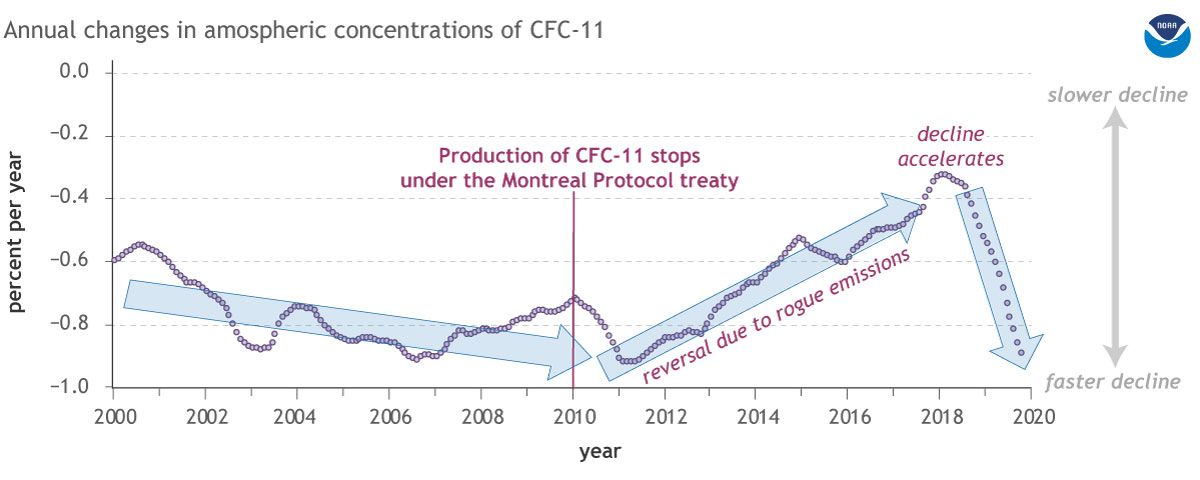Emissions of a banned ozone-depleting gas are back on the decline
2018 discovery posed first real test of the Montreal Protocol

New analyses of global air measurements show that five years after an unexpected spike in emissions of the banned ozone-depleting chemical chlorofluorocarbon CFC-11, emissions dropped sharply between 2018 and 2019.
The abrupt turnaround was detected by both NOAA’s global monitoring network and an independent global sampling network, the Advanced Global Atmospheric Gases Experiment (AGAGE), funded in part by NASA. Results showing a global emission decrease in CFC-11, by a team of scientists from the United States, including from CIRES, the United Kingdom and Australia, as well as a companion regional analysis by a second international team showing a decline in emissions from eastern Asia, were published today in the journal Nature.
The twin papers indicate that efforts to address the first known substantive violation of the international treaty tasked with ensuring stratospheric ozone layer recovery, known as the Montreal Protocol, are working. “This was a major test of the Montreal Protocol, and it appears to have passed,” said NOAA scientist and CIRES Fellow Stephen Montzka, who led the research team that first documented the problem in 2018.
Following that initial discovery, members of the treaty called for immediate action. China then announced renewed enforcement and inspections measures. Scientists began looking for results.
“It wasn’t long before the NOAA and AGAGE data were indicating a drop in emissions both globally and from eastern China,” Montzka said. “This is a great example of how important early warnings from observational systems can be. It’s pretty hard to solve a problem you don’t know exists.”
CFC-11 is the second-most significant member of a family of chemicals known to deplete Earth’s protective ozone layer. Once widely used in the manufacture of aerosol sprays, as blowing agents for foams and packing materials, as solvents, and in refrigeration, its production was banned in 2010, although CFC-11 continues to leak from foam building insulation and appliances manufactured before that year. While the amount of CFC-11 in the atmosphere is only a few hundred parts per trillion, it plays a primary role in the formation of the ozone hole over Antarctica each September, and year-round depletion of the stratospheric ozone layer in the mid-latitudes. Ozone depletion causes thinning of the ozone layer, which shields the planet from potentially harmful ultraviolet radiation that can cause skin cancer and cataracts, suppress immune systems and also damage plants.

This graph depicts the annual changes in the atmospheric concentrations of CFC-11 obtained from analysis of samples from the NOAA and AGAGE monitoring networks from 2000 to 2020. Credit: NOAA Global Monitoring Laboratory and Climate.gov
In 2018, a research team led by Montzka—and including CIRES scientists—announced that from 2014 to 2016, emissions of CFC-11 had increased by more than 13,000 tonnes per year (or 14,000 U.S. tons) to about 59,000 tonnes (65,000 U.S. tons) per year, a jump of 25 percent above average emissions from 2002 to 2012. A followup investigation by AGAGE, NOAA and CIRES scientists determined that at least 40 to 60 percent of the global emission increase came from eastern mainland China, primarily from China’s Shandong and Hebei provinces.
The new results show that from 2018 to 2019, emissions of CFC-11 decreased globally by 18,000 tonnes per year (or about 20,000 U.S. tons) to 52,000 tonnes per year (57,000 U.S. tons), a decline of 26 percent. Current annual emissions now appear to have returned to pre-2012 levels.
CIRES scientists Geoff Dutton, Eric Ray, Carolina Siso, and David Nance are co-authors on the research paper, “A decline in global CFC-11 emissions during 2018−2019.”
This story was written by NOAA communications. Read the full story here.